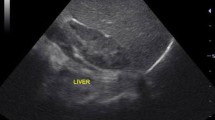Abstract
Objective
This study was aimed to determine the location and development of the spleen in the human fetuses.
Materials and methods
The study was carried on 141 dead human fetuses aged between 9 and 40 weeks with no marked pathology and anomaly in the years 2002–2003. The location of spleen with the neighboring structures, the existence of accessory spleens, notches on the borders, fissures on the surfaces, major ligaments and the shape of spleen and its hilum were established. The spleen was completely observed intraperitoneally (except at the hilum), in the left hypochondrium throughout the fetal period. The length, width, thickness, weight, volume, and the hilum dimensions of spleen were measured.
Results
The dimensions, weight, and volume of the spleen were increased with the gestational age, and positive significant correlations were determined (P < 0.001). There was no difference between sexes in all parameters (P > 0.05). The length of the spleen has ranged between 3.1 and 35.6 mm, between 9 weeks old and 40-week-old fetuses, respectively. One or more accessory spleens have been found in 14% of cases.
Conclusion
The measurements and location of the spleen according to the gestational age were determined by the present study. The expression of morphometric parameters of the spleen at different gestational ages can be used in determination of pathologies of the spleen and may also contribute to future studies on this issue.

Similar content being viewed by others
References
Aoki S, Hata T, Kitao M (1992) Ultrasonographic assessment of fetal and neonatal spleen. Am J Perinatol 9(5/6):361–367
Bergman RA, Afifi AK, Miyauchi R. (2006) Virtual hospital illustrated encyclopedia of human anatomic variation: opus IV: organ systems: digestive system and spleen http://www.anatomyatlases.org/AnatomicVariants/OrganSystem/Text/Spleen.shtml
Borley NR (2005) Liver. In: Standring S (ed) Gray’s anatomy, 39th edn. Churchill Livingstone, London pp 1213–1225
Borley NR (2005) Spleen. In: Standring S (ed) Gray’s anatomy, 39th edn. Churchill Livingstone, London pp 1239–1244
Collins P (2005) Development of the peritoneal cavity, the gastrointestinal tract and its adnexae. In: Standring S (ed) Gray’s anatomy, 39th edn. Churchill Livingstone, London p 1256
Collins P (2005) Development of the peritoneal cavity, the gastrointestinal tract and its adnexae. In: Standring S (ed) Gray’s anatomy, 39th edn. Churchill Livingstone, London p 1267
Eraklis A, Fitter R (1977) Splenectomy in childhood: a review of 1413 cases. J Pediatr Surg 7:382–388
Ferreira GFB, Rega RMS, Mandarim-De-Lacerda CA (1992) Spleen’s relative growth in human fetuses. Bull Assoc Anat (Nancy) 76(233):23–25
Griffith RC, Junney CG (1985) Hematopoietic system. Bone marrow and blood, spleen and lymph nodes. In: Kissane JM (ed) Anderson’s pathology, vol 2, 9th edn. St Louis, Mosby, p 1408
Guihard-Costa AM, Menez F, Delezoide AL (2002) Organ weights in human fetuses after formalin fixation: standards by gestational age and body weight. Pediatr Dev Pathol 5:559–578
Hansen K, Sung CJ, Huang C, Pinar H, Singer DB, Oyer CE (2003) Reference values for second trimester fetal and neonatal organ weights and measurements. Pediatr Dev Pathol 6(2):160–167
Hata T, Deter RL, Aoki S, Makihara K, Hata K, Kitao M (1992) Mathematical modeling of fetal splenic growth: use of the Rossavik growth model. J Clin Ultrasound 20:321–327
Marecki B (1989) The formation of the proportions of the liver, spleen and kidneys in the fetal ontogenesis. Z Morphol Anthropol 78(1):117–132
Moore KL, Dalley AF (1999) Clinically oriented anatomy, 4th edn. Lippincott Williams & Wilkins, Maryland pp 256–271
Moore KL, Persaud TVN (1998) The developing human, clinically oriented embryology. 6th edn. W.B. Saunders Company, Philadelphia pp 107–129
Otto AC, Ninham E, Pretorius PH, Wagner L, Rhonda du Toit DJ, Schall R (1994) Difference between splenic volume measured at necropsy and that measured in vivo by radionuclide tomography. Clin Nucl Med 19(11):979–980
Poulin EC, Thibault C (1993) The anatomical basis for laparoscopic splenectomy. Can J Surg 36(5):484–488
Schmidt W, Yarkoni S, Jeanty P, Grannum P, Hobbins John C (1985) Sonographic measurements of the fetal spleen: clinical implications. J Ultrasound Med 4:667–672
Singer DB (1991) Disorders of the lymphoid tissues and the immune system. In: Wigglesworth JS, Singer DB (eds) Textbook of foetal and perinatal pathology, vol 1. Blackwell, Boston, pp 499–524
Singer DB, Sung CJ, Wigglesworth JS (1991) Fetal growth and maturation: with standards for body and organ development. In: Wigglesworth JS, Singer DB (eds) Textbook of fetal and perinatal pathology, vol 1. Blackwell, Boston, pp 11–47
Skandalakis P, Colborn GL, Skandalakis LJ, Richardson DD, Mitchell WE, Skandalakis JE (1993) The surgical anatomy of the spleen. Surg Clin North Am 73(4):747–767
Soyluoğlu Aİ, Tanyeli E, Marur T, Ertem AD, Özkuş K, Akkın SM (1996) Splenic artery and relation between the tail of the pancreas and spleen in a surgical anatomical view. Karadeniz Tıp Dergisi 9(2):103–107
Wadham B, Adams P, Johnson M (1981) Incidence and location of accessory spleens. N Engl J Med 304(18):1111
Acknowledgment
Written consent from the families and an approval from the Ethics Board of Süleyman Demirel University Medical Faculty were obtained prior to the commencement of the study and our applications comply with the current laws of our country.
Author information
Authors and Affiliations
Corresponding author
Rights and permissions
About this article
Cite this article
Üngör, B., Malas, M.A., Sulak, O. et al. Development of spleen during the fetal period. Surg Radiol Anat 29, 543–550 (2007). https://doi.org/10.1007/s00276-007-0240-2
Received:
Accepted:
Published:
Issue Date:
DOI: https://doi.org/10.1007/s00276-007-0240-2




